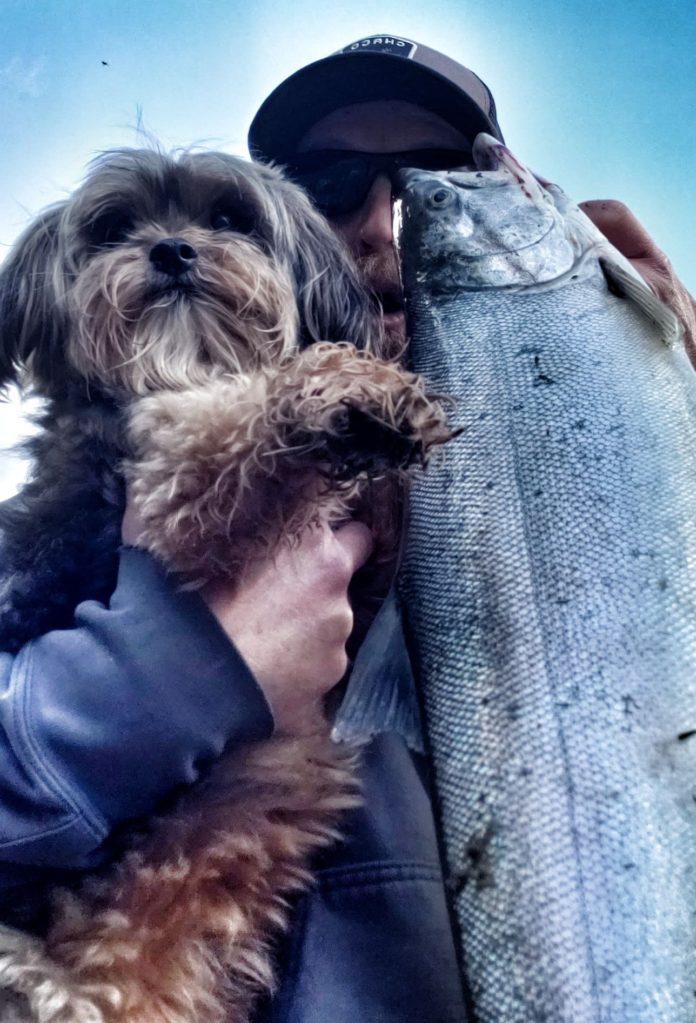By Andrew Cremata
There is a place near Skagway where a lake ends and a river begins. As water flows toward the river’s source, it picks up speed. An assortment of debris is funneled into the bottleneck, including insects, baitfish and wayward salmon eggs.
At first daylight, birds gather for the day’s feast. A family of mergansers dives for small fish until the current carries them downriver and they fly back to their starting point for another turn. Two kingfishers call to one another as they dart back and forth along the water’s edge. Bald eagles perched in spruce wait for larger fare while an American dipper bounces up and down on a small boulder.
Gulls are everywhere and always making the most of their opportunities. Ravens call from the woods while crows and jays make random appearances on trees that line the banks.
A variety of fish are also active. Cutthroat trout attack insects on the surface while Dolly Varden char collect salmon eggs below. Healthy salmon swim into the lake while dying salmon struggle against the unyielding current.
When the salmon are running, brown bears frequent the area. During the morning hours, it’s not uncommon to see multiple brown bears foraging along the shoreline for a hearty meal. Each has its own hunting style. When they have their fill, they disappear back into the woods
As the morning matures, humans begin to arrive. Some have boats. Most have fishing rods. A few of them manage to catch a salmon or two. By mid-afternoon, the fishermen outnumber the fish and the mergansers call it a day.
When the sun sinks beneath the mountains, the air chills and the sky turns pink. The air quickly cools and the only sound is moving water.
Throughout the summer and into the fall, this scene plays out daily. From July to October, it’s possible to watch the merganser ducklings fully mature into adults. In that same timespan, pink salmon run strong and then begin to die off as coho take their place.
There are many such places filled with elemental symmetry in Alaska. Each has its own distinct rhythm but the only way to discern the beat is to stop and listen.
The best anglers are keen observers. The most successful fishermen seek to peer beneath the shallow veneer of the sport to decipher natural laws that lead to success.
Using expensive fishing rods and reels to cast overpriced lures is meaningless if the water holds no fish. This simple truth underscores the fact that material pursuits seldom bring fulfillment. More gear doesn’t equate to more fish. In fact, the opposite is often true.
A $5 fishing pole bought at a garage sale will catch just as many fish as a $500 dollar rig sold at a “pro” shop. Fishing books, videos, television shows and magazines promote the idea that fishing is complicated because they understand that, in our modern culture, manufactured mysteries are best solved with dollars and cents.
An hour spent watching nature unfold before making the first cast is more valuable than the sum total of all fishing media. Both for catching fish and for contemplating mysteries.
When I was a teenager, I had a friend named Joel who loved to fish for speckled trout. He fished the canal walls barefoot using a beat-up Zebco 404 spincast rod and reel combo. Most people who have never been fishing have likely seen a Zebco 404 because they are often used by children, due to the fact that they are cheap and durable.
While most anglers use a Zebco for small freshwater fish, Joel used his to target big trout in saltwater.
A couple of the eyelets on the rod were missing and there was a good deal of corrosion on the reel housing. Any reasonable person would have assumed it was junk because nobody in their right mind would have spent a dollar to buy it at a yard sale.
In Joel’s hands, it was a piece of art – a Stradivarius for utterly destroying speckled trout.
On a sweltering summer afternoon, I watched Joel battle a trout for nearly 30 minutes as it ran him from one end of the canal wall to the other and back again multiple times. Joel deftly dodged spots where the seawall was crumbling and leaped over patches of sand spurs as though his bare feet had eyes. Then he suddenly jumped down into the water and when he climbed back up over the seawall he was holding a massive trout that easily topped 14 pounds.
Forty-five minutes later he reeled in another trout nearly as big as the first.
A few months passed. While fishing from a local bridge, Joel hooked up on something big. Midway through the fight, his fishing rod snapped in half from the strength of the fish. Joel threw down the rod and hand-lined the fish the rest of the way up to the surface where I helped him land it. The fish was a black drum around 40 pounds. Joel promptly traded the fish to a random bridge angler in exchange for another rod and reel.
Later that day, I asked Joel if he was sad about his Zebco breaking.
“Nah,” he answered. “I don’t care about it. I don’t go fishing to play with my gear. I go fishing to catch fish.”
Credit: Source link






























